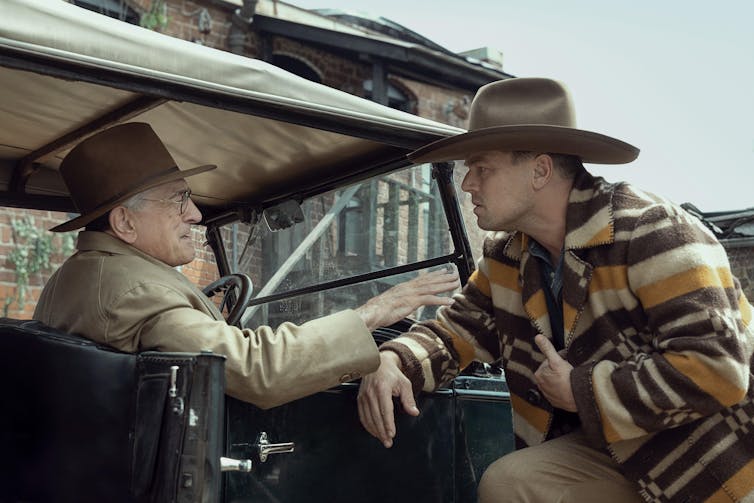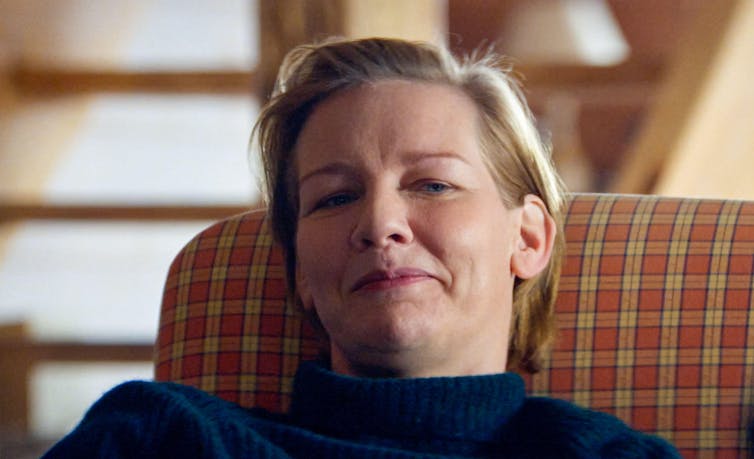This article was first published in our email newsletter Something Good, which every fortnight brings you a summary of the best things to watch, visit and read, as recommended and analysed by academic experts. Click here to receive the newsletter direct to your inbox
It’s that time of year again when sensible women everywhere pray that gushing reporters on the red carpet will resist the temptation to ask female actors: “So who are you wearing this evening?” Yes, it’s Oscar time again on Sunday.
This year presents an interesting and eclectic line-up of films across all the main categories, with most of 2023’s big box office hits reflected in the nominations. (But let’s not even get started on Barbie, which bafflingly saw director Greta Gerwig – the first woman to hit the US$1 billion mark at the box office – and her hilarious lead, Margot Robbie, all but ignored.) Personally, I was sad to see the gentle and rather lovely All of Us Strangers left out, and the mesmerising Greta Lee unjustly overlooked in Past Lives.
BFA / Alamy
While Men Doing Important Things has caught the attention of the academy again this year, women represent almost a third of all nominees – the highest proportion ever (tying with 2021). Diversity across most categories is also showing marked improvement since 2015, when not a single person of colour was among the 20 actor nominations, prompting the instantly trending hashtag #OscarsSoWhite.
Read more:
Oscars 2024: Four Daughters is a Tunisian masterpiece – what makes the film groundbreaking
Perhaps most interesting this year is the race for best actress, in which five exceptional performances – Native American actress Lily Gladstone for Killers of the Flower Moon; Annette Bening for against-all-odds swimming drama Nyad; Emma Stone for the delightfully bonkers Poor Things; Carey Mulligan for the Leonard Bernstein biopic Maestro; and Sandra Hüller for French feminist courtroom thriller Anatomy of a Fall – will make the judges’ job extremely tricky.
Our expert academics are here to bring you their take on the five movies that have been nominated for both best picture and best director – and several other categories too.
Tough guys and psychopaths
With Barbie pretty much out of the picture, two very male-dominated films, Christopher Nolan’s Oppenheimer and Martin Scorsese’s Killers of the Flower Moon have dominated the running this year.
Read more:
Bradley Cooper, Cillian Murphy and the myths of Method acting
Nolan’s three-hour film is an exploration of the life and work of American scientist Robert Oppenheimer, creator of the atomic bomb dropped on the Japanese cities of Hiroshima and Nagasaki to bring the second world war to an end.

Pictorial Press Ltd / Alamy
Lecturer in screen composition Alison Cole describes Oppenheimer’s soundtrack as “epic”, praising Ludwig Göransson’s score as it immerses the audience in the inner turmoil of a man on the brink of unleashing the potential destruction of humanity. She also examines the construction of the sound design as it illustrates flashbacks, physical phenomena and atoms clashing with each other. But Cole concludes that it is the film’s silences that constitute the most powerful aural backdrop to the events unfolding on screen.
Ukrainian academic Viktoriia Grivina watched the film in her home town, noting how the soundscape of explosions is a familiar and deadly part of daily life in towns and cities across her country – something Grivina feels the wider world doesn’t fully grasp. For the people of Ukraine, Oppenheimer’s Greek tragedy is their reality.

FlixPix / Alamy
Possibly Scorsese’s last film, Killers of the Flower Moon sees the quiet but captivating performance of Native American actor Lily Gladstone rightly nominated for best actress. Jacqueline Fear-Segal explains what Gladstone winning the accolade would mean for Native Americans in an industry that has persistently reduced them to stereotypes since film began.
Read more:
Gangsters are the villains in ‘Killers of the Flower Moon,’ but the biggest thief of Native American wealth was the US government
The movie traces the true story of greed, brutality and government complicity in the assassination of wealthy citizens of the oil-rich Osage Nation. Indigenous cultures scholar Shannon Toll reveals how the betrayal still lingers for many in the community today.
Jonathan Glazer’s Zone of Interest is a chilling exploration of the banality of evil, focusing on a German SS officer’s family who live in a charming house and garden right next to the Auschwitz concentration camp.
Based on Martin Amis’s novel of the same name, it examines how brutal instincts are woven intricately into the human condition, and that the dividing line between the normal and the repugnant is perilously thin. Despite it being a haunting and disturbing watch, reviewer Paul Giles argues that the film carries nothing like the charge or challenge of the original novel.

A24
Film academic Archie Wolfman also explains how the movie shows that genocide is perpetrated not by “evil”, but by administrators coldly obsessed with lists, numbers and logistics. Those, he says, are the mechanisms that make mass murder possible.
Feminist fears and adventures
In Anatomy of a Fall, best actress nominee Sandra Hüller gives an astonishingly naturalistic performance as a writer accused of murdering her husband, after he dies in a fall from the balcony of their home. While our reviewer Huw D. Jones claims the film has single-handedly revived French arthouse cinema, Blythe Worthy examines the conflicting roles of wife, mother and writer in director Justine Triet’s forensic evisceration of the patriarchy, set against the backdrop of a flawed French legal system.

Landmark Media / Alamy
Greek filmmaker Yorgos Lanthimos’s Frankenstein-steampunk romp Poor Things has delighted audiences since its release last year – but its energetic and seemingly endless sex scenes also repelled many cinema goers. Its most controversial scene involves children witnessing sex, while Emma Stone’s Bella Baxter begins the movie with a child’s brain in a woman’s body.
Read more:
The swashbuckling score for Poor Things sets the tone for an eccentric heroine’s journey
Teen researcher Saskia Roberts argues Poor Things is about the sexuality of girls, accurately depicting their early sexual feelings and discovery of masturbation. It also, Roberts says, shows more positive ways of understanding girlhood sexual desire, as we follow Bella Baxter from curious youngster to flamboyant Parisian brothel worker.

GL Portrait / Alamy
Many Scots were a little miffed that Hollywood excised the Glasgow setting and transposed it instead to some Disneyfied, 19th-century-slash-futuristic realm. It would be interesting to know how Alasdair Gray, the Glaswegian whose novel the film is based on, would have viewed it.
Gray, who died in 2019 at the age of 85, is a much-loved figure on the Celtic literary landscape, a radical visionary and Scottish nationalist known for his painting as much as his writing. Joe Jackson looks at the life of the polymath maverick, whose bold creative approach has had an immense influence on contemporary Scottish literature and beyond. I like to think Gray would have graciously embraced the Hollywood version and enjoyed it – I certainly did.

Looking for something good? Cut through the noise with a carefully curated selection of the latest releases, live events and exhibitions, straight to your inbox every fortnight, on Fridays. Sign up here.



















:max_bytes(150000):strip_icc()/Health-GettyImages-1339728990-1bf6270deb774df8b176c25081771051.jpg?w=120&resize=120,86&ssl=1)
